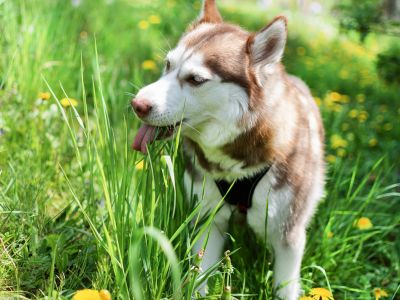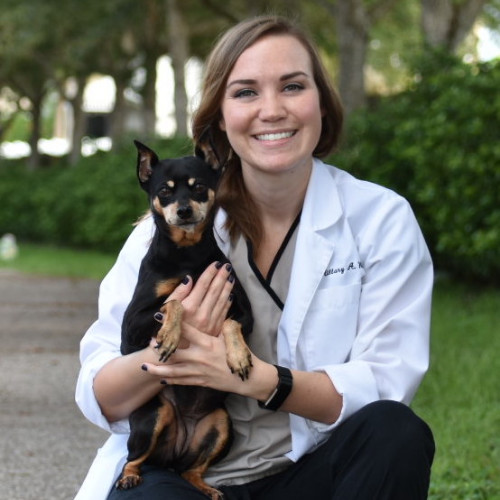As one of the most common ingredients found in kitchens around the world, garlic is a flavorful addition to many dishes we humans enjoy. However, for our furry friends, it can present a substantial risk. It’s imperative that dog owners understand the potential dangers of garlic and the importance of keeping it out of their dog’s reach.

What Makes Garlic Dangerous for Dogs?
Garlic belongs to the Allium family, which also includes onions, leeks, and chives. These plants contain a compound called thiosulfate, which is harmless to humans but toxic to dogs1. Thiosulfate can lead to a condition called hemolytic anemia in dogs. Hemolytic anemia is a condition where red blood cells are destroyed faster than they can be produced, leading to a shortage of red blood cells in the body. In severe cases, this can result in organ damage, organ failure, or even death.
Variables Influencing the Danger of Garlic
The toxicity of garlic for dogs depends on various factors. These include the amount consumed, whether the garlic was cooked or fresh, the size and weight of your dog, and the concentration of thiosulfate in the particular variety of garlic.
Generally, larger dogs can tolerate more garlic than smaller ones before showing symptoms of poisoning. However, even small amounts can be harmful, particularly when consumed regularly over a period of time. While cooking garlic can reduce its toxicity, it does not entirely eliminate the thiosulfate content, meaning that cooked garlic can still be harmful to dogs.
The toxicity threshold for garlic in dogs is roughly 0.5 ounces of garlic per 10 pounds of body weight. This means that a small clove of garlic can be harmful to a dog weighing 10 pounds or less, while several cloves may be dangerous for larger dogs. However, since dogs can react differently and smaller amounts can build up over time, it’s safest to avoid garlic entirely. Consult your vet for any dietary concerns.
Recognizing Garlic Poisoning in Dogs
Garlic poisoning in dogs can result in a range of symptoms that may not be immediately apparent.
- Fatigue: Dogs experiencing garlic poisoning may show signs of lethargy or appear more tired than usual. They might show reluctance to participate in activities they usually enjoy, like walking or playing.
- Weakness: Is your dog having difficulty standing up, maintaining balance, or walking? You may notice them stumbling or appearing less coordinated than usual.
- Pale Gums: Normally pink gums might turn pale or white, indicating a loss of red blood cells. This change can be gradual, and you should regularly check your dog’s gum color as a health indicator.
- Increased Heart Rate: A dog suffering from garlic toxicity may have a rapid heart rate, which can cause them to pant heavily even when at rest. This happens as the body tries to compensate for the lack of oxygen caused by a reduction in red blood cells.
- Increased Respiratory Rate: Similar to the increased heart rate, the dog’s breathing may also speed up. They might seem to struggle for breath or pant excessively, even in cool temperatures.
- Vomiting and Diarrhea: Digestive disturbances such as vomiting or diarrhea can also occur. The vomit or stool may contain blood or appear unusual in color or consistency.
- Collapse: In severe cases, the dog might suddenly collapse. This can be due to the body being unable to sufficiently circulate oxygen due to reduced red blood cells.
- Dark-Colored Urine: As red blood cells are destroyed, byproducts may darken the urine. The urine might turn a brown or reddish color, which can be an indicator of hemolytic anemia.
- Jaundice: Dogs with advanced garlic poisoning may exhibit signs of jaundice, characterized by a yellowing of the skin, eyes, and gums. This occurs when the liver is unable to process the byproducts of red blood cell destruction.
As always, if you observe any of these symptoms in your dog, contact a veterinarian for advice and treatment options.
What to Do in Case of Potential Garlic Poisoning
While home remedies for minor ailments can sometimes be helpful, garlic toxicity in dogs is a serious condition that requires professional veterinary intervention. It’s crucial to contact a vet or a pet poison helpline immediately if you suspect your dog has ingested garlic.
There aren’t any safe and effective home remedies for garlic toxicity, and trying to treat your pet at home could lead to delays in treatment and potentially worsen their condition.
While the occasional accidental ingestion of a very small amount of garlic may not cause severe symptoms in a large dog, it’s still best to consult a veterinarian. The risk and severity of garlic poisoning depend on several factors like the dog’s size, the amount consumed, and the specific variety of garlic. Even seemingly minor symptoms can evolve over time, so it’s always better to be safe and seek professional advice.
Conclusion
Garlic, while a staple in human diets, poses a serious health risk to our canine companions. It’s crucial for pet owners to be aware of the dangers, recognize the signs of garlic poisoning, and know what to do in case of ingestion. Remember, prevention is always better than cure: it’s best to keep garlic and foods containing garlic safely out of your dog’s reach. Stay informed and help keep your best friend healthy and safe.
Citations
Allium species poisoning in dogs and cats, (2011).
Frequently Asked Questions About Dogs Eating Garlic
-
It’s advisable to avoid feeding your dog foods with garlic, including those with small amounts. Even foods that we might consider “safe” due to their low garlic content can lead to cumulative toxicity if given regularly over time. Always check the ingredient lists on pet food products and treats, as some might contain garlic or garlic powder.
-
Yes, even if your dog shows no immediate signs of distress after consuming garlic, you should still reach out to a vet. The symptoms of garlic toxicity can be delayed, making early veterinary consultation vital to averting severe health complications.
-
If your dog picked up garlic but spit it out without swallowing, it’s unlikely they ingested enough to cause toxicity. However, you should still monitor them closely for any unusual behavior or symptoms like vomiting, diarrhea, weakness, or changes in heart or breathing rates. If you notice any such signs or are uncertain, it’s best to consult a vet for peace of mind and safety.

